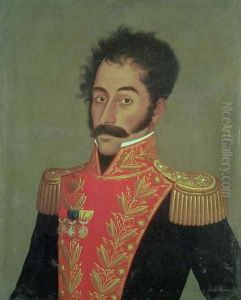Gil de Castro Paintings
José Gil de Castro, known as Gil de Castro, was a prominent painter of the late 18th and early 19th centuries, born in 1785 in Lima, Peru. His artistic contributions are primarily recognized in the realm of portrait painting, where he became the most sought-after portraitist among the military and political elites of his time in South America. Gil de Castro's works are pivotal in understanding the visual culture and political shifts occurring during a significant period of Latin American history, particularly the era of independence from Spanish rule.
Gil de Castro's early life and training remain somewhat obscure, but it is known that he was of African descent and possibly received initial training from local artists in Lima. His style reflects a blend of European and local artistic traditions, which he adeptly combined to create portraits that were both sophisticated and deeply expressive. By the early 19th century, he had established himself in Lima, and his reputation as a portraitist grew rapidly, allowing him to expand his influence and clientele across the continent.
During the 1810s and 1820s, as struggles for independence swept through South America, Gil de Castro's work became intrinsically linked with the revolutionary movements. He painted portraits of key figures in the independence movements, including Simón Bolívar and José de San Martín, among others. These portraits not only served as powerful symbols of the new political order but also helped to establish a visual identity for the emerging nations of Latin America.
In addition to his political and military portraits, Gil de Castro painted religious subjects and scenes from daily life, showcasing his versatility as an artist. However, it is his portraits that have left a lasting legacy, characterized by their vivid realism and psychological depth. His ability to capture the nuances of his subjects' personalities and his sophisticated use of color and light make his works stand out among his contemporaries.
Gil de Castro spent the latter part of his career in Chile, where he continued to work and teach until his death in 1841. Though he may not be as widely recognized as some of his European contemporaries, his contribution to the art and history of South America is undeniable. Today, his works are held in high esteem and can be found in museums and collections across the continent, serving as a testament to his skill and his role in the cultural and political transformations of his time.
